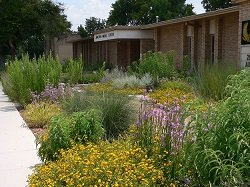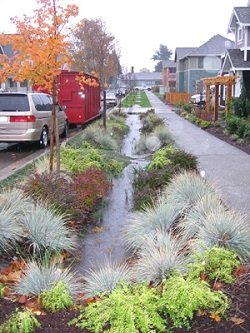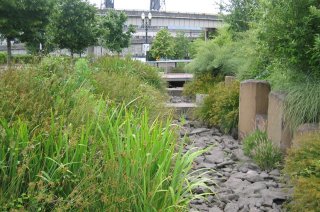Alternative Site Stormwater Management
Off-Site Stormwater Management
On this page:
- What is off-site stormwater management?
- When to consider off-site stormwater management
- Benefits of off-site stormwater management
- Examples of MS4 permit language addressing off-site stormwater management
- EPA Resources
- Non-EPA Resources
What is off-site stormwater management?
Many local and state governments have established performance and/or design standards to manage post-construction stormwater discharges for certain new development and redevelopment projects. In some instances, these standards may not be achievable within the boundaries of the new development or redevelopment site itself. Off-site stormwater management provides a way for operators of these projects to meet these performance standards at a location outside the right-of-way (ROW) or limit of the area of development.

Sometimes a community’s municipal separate storm sewer system (MS4) is regulated under the National Pollutant Discharge Elimination System (NPDES) program and these performance or design standards are set as requirements within MS4 permits. Where this is the case, some permits allow for the use of off-site stormwater management as an alternative to meeting these requirements on site, under certain circumstances.
Permit terms can specify the conditions under which off-site stormwater management may be used, and restrictions on its use such as limiting it to the same watershed or sub-watershed as the site. In these cases, MS4 permit holders have the flexibility to develop stormwater management programs that include allowances for managing this post-construction stormwater off site.
Off-site stormwater management programs can use a variety of approaches. For example, the permittee itself may choose to manage the off-site stormwater program, including program credit tracking, or may choose to have a central entity do so. They may also choose to include an option for developers to contribute “in-lieu fees” to a centrally managed account to support installation and maintenance of off-site stormwater management projects.
The term “off-site stormwater management”
EPA uses the term “off-site stormwater management” to describe meeting performance standards for post-construction stormwater discharges in a location other than where the development/redevelopment is happening. Off-site stormwater management can be implemented through a variety of mechanisms (e.g., “stormwater credit trading,” “off-site mitigation,” “in lieu fees”). Here, EPA uses the term “off-site stormwater management” to reduce possible confusion by distinguishing this term from other unrelated terms, such as water quality trading and compensatory mitigation under Clean Water Act Section 404.
If off-site stormwater management is allowed under local regulations and applicable permits, when may you want to consider it?

- The land to install post-construction stormwater controls within the existing project boundaries or ROW is unavailable, therefore installing stormwater controls is physically infeasible. For example, the following types of areas may pose challenges:
- Densely developed areas
- Rocky sites
- Steep sites
- Linear construction projects related to bridges, roadways, and electrical and telecommunication utilities
- Any existing structural stormwater management practices on site are insufficient to address water quality requirements since they may be undersized or unable to fully manage the stormwater discharges on site alone
- The site has impediments to managing stormwater onsite through infiltration, for example:
- Buried utilities
- Historic areas
- Proximity to current or future drinking water aquifer or drinking water well
- Proximity to known pollutant hot spots such as hazardous waste sites, landfills, gas stations, or brownfields
- Soils that do not allow for sufficient infiltration
- A “green streets” or “green and complete streets” project may incorporate stormwater management through green infrastructure located slightly outside of the ROW
What are the potential benefits of off-site stormwater management?

- Provides regulatory flexibility for project developers to meet their local stormwater requirements without the use of a waiver from meeting local requirements
- Improves local waterways and benefits communities by providing a means to meet numeric performance standards that protect water quality
- Provides an opportunity for local governments and developers within the community to cooperate in reducing the impacts of stormwater discharges more holistically
- Can help achieve additional environmental and planning goals, such as:
- Flood mitigation
- Implementation of stormwater controls and green infrastructure in areas not undergoing development and in historically underserved areas
- Modernizing of stormwater systems to enhance resilience for the built environment
- Enhances the ability to quantify volume and pollutant reductions, promoting accountability and helping MS4 permittees document achievement of their regulatory obligations
- Mitigates safety concerns associated with working inside the ROW of busy roadways
- May be more effective, efficient, and cost-effective than on-site management
What are examples of MS4 permit language addressing off-site stormwater management?

- District of Columbia MS4 permit (issued by EPA, 2023) allows part of the required on-site retention requirement to be compensated for with “off-site mitigation” and/or “in-lieu fee” programs and refers to the city’s “Stormwater Retention Credit Program.” (sections 3.2.2-3.2.4)
- Massachusetts MS4 permit (issued by EPA, 2016, modified 2020) includes option for “off-site mitigation” within the same USGS HUC12 for new development or redevelopment projects. (pages 45-46)
EPA Resources
- Financing Stormwater Management Infrastructure Learning Module
- View webinar on using on-site stormwater management to promote green infrastructure
- Case Studies of Successful Approaches to Off-Site Stormwater Management
- EPA Stormwater program: Compendium of MS4 Permitting Approaches: Compendium Part 7: Off-Site Stormwater Management (pdf)
- EPA Stormwater program: Compendium of MS4 Permitting Approaches: Compendium Part 2: Post-Construction Standards (pdf)
- EPA Stormwater financing webinar series:
- EPA Clean Water State Revolving Fund (CWSRF)
- Washington DC’s Stormwater Retention Credit Program
- EPA Region 9: Stormwater Crediting Lessons from Wetland Mitigation
- EPA Green Infrastructure Technical Assistance Program: Fairview Avenue Green Street Conceptual Design: Evaluating Off-site Mitigation through Green Infrastructure within a Public Right-of-Way
Non-EPA Resources
- California State Water Resources Control Board: STORMS Storm Water Strategy Webinar: Building Blocks for Offsite Stormwater Credit Programs
- Southern New England Program: New England Stormwater Retrofit Manual
- Environmental Financial Advisory Board: Evaluating Stormwater Infrastructure Funding and Financing
- Water Environment Federation, American Rivers, and Great Lakes Protection Fund: Establishing a Stormwater Volume Credit Trading Program: A Practical Guide for Stormwater Practitioners (pdf)
- National Cooperative Highway Research Program: Watershed Approach to Mitigating Hydrologic Impacts of Transportation Projects: Guide (2022)
- National Cooperative Highway Research Program: A Watershed Approach to Mitigating Stormwater Impacts (2017)
- Center for Watershed Protection: Guidance for Developing an Off-site Stormwater Compliance Program for Redevelopment Projects in Massachusetts
